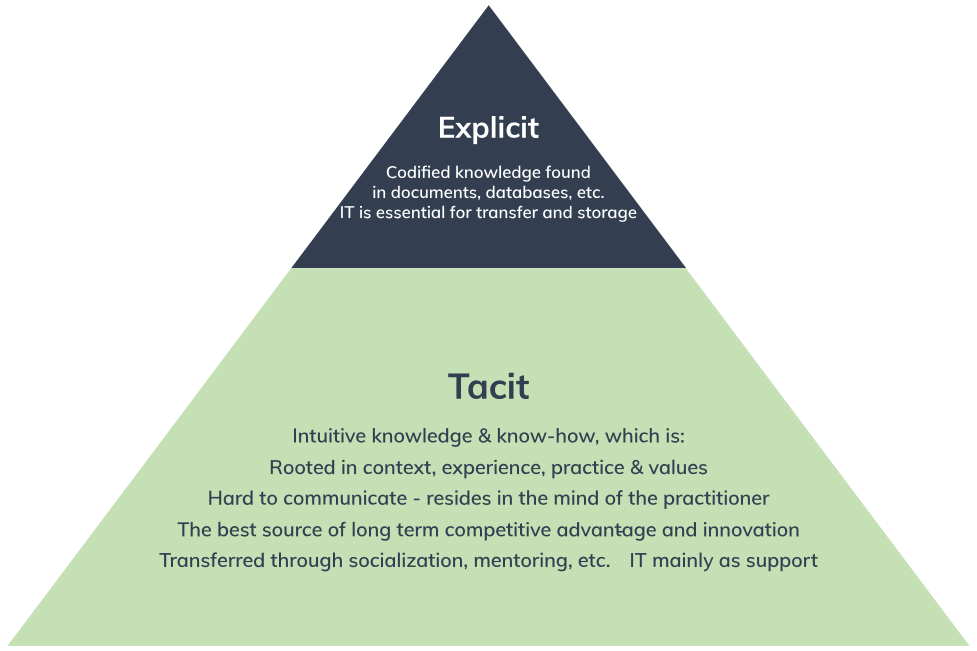Understanding the different forms that knowledge can exist in, and thereby being able to distinguish between various types of knowledge, is an essential step for knowledge management (KM). For example, it should be fairly evident that the knowledge captured in a document would need to be managed (i.e. stored, retrieved, shared, changed, etc.) in a totally different way than that gathered over the years by an expert craftsman.
Over the centuries many attempts have been made to classify knowledge, and different fields have focused on different dimensions. This has resulted in numerous classifications and distinctions based in philosophy and even religion. Though not directly related to our purpose here, the wikipedia article on knowledge provides some interesting background reading (go to article).
Within business and KM, two types of knowledge are usually defined, namely explicit and tacit knowledge. The former refers to codified knowledge, such as that found in documents, while the latter refers to non codified and often personal/experience-based knowledge.
KM and organisational learning theory almost always take root in the interaction and relationship between these two types of knowledge. This concept has been introduced and developed by Nonaka in the 90's (e.g. Nonaka 1994) and remains a theoretical cornerstone of this discipline. Botha et al (2008) point out that tacit and explicit knowledge should be seen as a spectrum rather than as definitive points. Therefore in practice, all knowledge is a mixture of tacit and explicit elements rather than being one or the other. However, in order to understand knowledge, it is important to define these theoretical opposites.
Some researchers make a further distinction and talk of embedded knowledge. This way, one differentiates between knowledge embodied in people and that embedded in processes, organizational culture, routines, etc. (Horvath 2000). Gamble and Blackwell (2001) use a scale consisting of represented-embodied-embedded knowledge, where the first two closely match the explicit-tacit.
Without question, the most important distinction within KM is between explicit and tacit knowledge. However, I find that the embedded dimension is a valuable addition, since the managerial requirements for this type of knowledge are quite different. For this reason, the discussions on this site will, when relevant, use all three categorizations of knowledge but the focus will always be primarily on the explicit-tacit dimension.
Below I present an overview of these three categories, as well as a short discussion on the way knowledge management systems (KMS) can/cannot be used to manage them.
Explicit Knowledge
This type of knowledge is formalized and codified, and is sometimes referred to as know-what (Brown & Duguid 1998). It is therefore fairly easy to identify, store, and retrieve (Wellman 2009). This is the type of knowledge most easily handled by KMS, which are very effective at facilitating the storage, retrieval, and modification of documents and texts.
From a managerial perspective, the greatest challenge with explicit knowledge is similar to information. It involves ensuring that people have access to what they need; that important knowledge is stored; and that the knowledge is reviewed, updated, or discarded.
Many theoreticians regard explicit knowledge as being less important (e.g. Brown & Duguid 1991, Cook & Brown 1999, Bukowitz & Williams 1999, etc.). It is considered simpler in nature and cannot contain the rich experience based know-how that can generate lasting competitive advantage.
Although this is changing to some limited degree, KM initiatives driven by technology have often had the flaw of focusing almost exclusively on this type of knowledge. As discussed previously, in fields such as IT there is often a lack of a more sophisticated definition. This has therefore created many products labeled as KM systems, which in actual fact are/were nothing more than information and explicit knowledge management software.
Explicit knowledge is found in: databases, memos, notes, documents, etc. (Botha et al. 2008)
Tacit Knowledge
This type of knowledge was originally defined by Polanyi in 1966. It is sometimes referred to as know-how (Brown & Duguid 1998) and refers to intuitive, hard to define knowledge that is largely experience based. Because of this, tacit knowledge is often context dependent and personal in nature. It is hard to communicate and deeply rooted in action, commitment, and involvement (Nonaka 1994).
Tacit knowledge is also regarded as being the most valuable source of knowledge, and the most likely to lead to breakthroughs in the organization (Wellman 2009). Gamble & Blackwell (2001) link the lack of focus on tacit knowledge directly to the reduced capability for innovation and sustained competitiveness.
KMS have a very hard time handling this type of knowledge. An IT system relies on codification, which is something that is difficult/impossible for the tacit knowledge holder.
Using a reference by Polanyi (1966), imagine trying to write an article that would accurately convey how one reads facial expressions. It should be quite apparent that it would be near impossible to convey our intuitive understanding gathered from years of experience and practice. Virtually all practitioners rely on this type of knowledge. An IT specialist for example will troubleshoot a problem based on his experience and intuition. It would be very difficult for him to codify his knowledge into a document that could convey his know-how to a beginner. This is one reason why experience in a particular field is so highly regarded in the job market.
The exact extent to which IT systems can aid in the transfer and enhancement of tacit knowledge is a rather complicated discussion. For now, suffice it to say that successful KM initiatives must place a very strong emphasis on the tacit dimension, focusing on the people and processes involved, and using IT in a supporting role.
Tacit knowledge is found in: the minds of human stakeholders. It includes cultural beliefs, values, attitudes, mental models, etc. as well as skills, capabilities and expertise (Botha et al 2008). On this site, I will generally limit tacit knowledge to knowledge embodied in people, and refer separately to embedded knowledge (as defined below), whenever making this distinction is relevant.

Embedded Knowledge
Embedded knowledge refers to the knowledge that is locked in processes, products, culture, routines, artifacts, or structures (Horvath 2000, Gamble & Blackwell 2001). Knowledge is embedded either formally, such as through a management initiative to formalize a certain beneficial routine, or informally as the organization uses and applies the other two knowledge types.
The challenges in managing embedded knowledge vary considerably and will often differ from embodied tacit knowledge. Culture and routines can be both difficult to understand and hard to change. Formalized routines on the other hand may be easier to implement and management can actively try to embed the fruits of lessons learned directly into procedures, routines, and products.
IT's role in this context is somewhat limited but it does have some useful applications. Broadly speaking, IT can be used to help map organizational knowledge areas; as a tool in reverse engineering of products (thus trying to uncover hidden embedded knowledge); or as a supporting mechanism for processes and cultures. However, it has also been argued that IT can have a disruptive influence on culture and processes, particularly if implemented improperly.
Due to the difficulty in effectively managing embedded knowledge, firms that succeed may enjoy a significant competitive advantage.
Embedded knowledge is found in: rules, processes, manuals, organizational culture, codes of conduct, ethics, products, etc. It is important to note, that while embedded knowledge can exist in explicit sources (i.e. a rule can be written in a manual), the knowledge itself is not explicit, i.e. it is not immediately apparent why doing something this way is beneficial to the organization.
 Emil Hajric
Emil Hajric